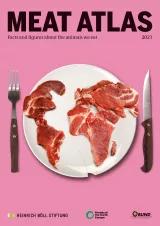One of the key demands of Fridays for Future, the youth climate movement, is “Listen to science!” In the age of Covid-19, governments frequently consult scientists and adapt policies to their advice. Scientists have also been stressing for over a decade that a climate- and biodiversity-friendly diet contains less than half the amount of meat consumed in industrialized countries today.

However, an ambitious and dedicated political shift in agriculture and food policy to tackle the climate crisis seems far away. The food and farming sector in industrialized countries, which accounts for about one-third of global greenhouse gas emissions, is far from doing its fair share to reduce them.
If the climate crisis failed to ring alarm bells, Covid-19 should have done so. The expansion of industrial agriculture at the expense of nature puts our global health at risk. The World Health Organization has been underlining the dire threat to global human health of zoonoses (infectious diseases transmitted via animals), which are closely linked to industrial meat and feed production around the globe. Furthermore, the terrible working conditions in slaughterhouses came to light during the first and second waves of the Covid-19 crisis, when meat factories turned into infection hotspots in many countries.
The fact that the meat industry keeps profiting throughout all crises while being subject to little regulation poses the question as to whom governments really listen to. While livestock corporations fuel the climate crisis, deforestation, pesticide use and biodiversity loss, and while they drive people off their land, they are still supported and financed by the world’s most powerful banks and investors, many of them from Europe. Policies, on the other hand – be they on animal welfare, trade or climate – include very few restrictions on this damaging industry. Strict, binding regulations for meat producers are often only achieved via citizens’ engagement – like the “End the Cage Age” campaign. This European Citizens’ Initiative for a ban on keeping animals in cages in the EU brought together over 170 organizations and was supported by 1.4 million people.
Citizens have long grasped the problem. The results of a survey commissioned for this report in Germany show that more than two-thirds of the younger generation reject today’s meat industry. Considering meat production a threat to the climate, they choose vegetarian or vegan diets twice as often as the population as a whole. And they see a need for action on the part of the government.
Contrarily to what politicians might claim, laws and regulations can steer our consumption decisions in favour of sustainability and health. There are numerous instruments for this: fiscal, informational and legal. European and national food strategies should contain such instruments, as well as those which support sustainable livestock breeding and a transition of the industry towards more locally embedded models in order to create fair and sustainable food environments. They should also reinforce environmental and social laws as well as animal welfare legislation in order to shift the focus of current industrial meat production to quality instead of quantity.
Eight years ago, we published the first Meat Atlas. Since then, a lot has changed in Europe and globally. Industrial meat has become a critical issue in society, the media and science. Consumers are increasingly turning to vegetarian products or to sustainably produced meat.
It is clear that many (especially young) people no longer want to accept the profit-driven damage caused by the meat industry and are increasingly interested in and committed to climate, sustainability, animal welfare and food sovereignty causes. We consider this an encouraging step for our future and want to use this Atlas to strengthen their commitment with information.
This Atlas is intended to support all those who seek climate justice and food sovereignty, and who want to protect nature. Revealing new data and facts, and providing links between various key issues, it is a crucial contribution to the work done by many to shed light on the problems arising from industrial meat production.

